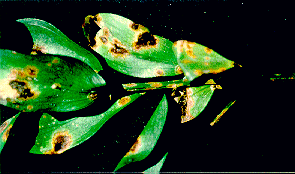
Return to: MREC Home Page
Return to: MREC Research Index
University of Florida, IFAS
Central Florida Research and Education Center - Apopka
CFREC-Apopka Research Report, RH-93-16
A. R. Chase*
Ruscus hypophyllum (Israeli/Holland ruscus) is a relatively new cut foliage crop which is becoming popular with retail florists. The stems are durable and may last up to 6 weeks even after storage at 4°C for one month. The single greatest problem faced by Florida ruscus growers is a bacterial leaf spot caused by Pseudomonas andropogonis. The disease has caused severe losses since 1989 and continues to spread throughout most nurseries when ruscus is in production (1). Like many bacterial leaf diseases, Pseudomonas leaf spot of ruscus is most severe when plants are exposed to overhead irrigation or rainfall and grown in a crowded condition which keeps plants wet for long periods of time. Trimming out stems with spots has been shown to be an effective means of reducing disease severity even when plants were purposely infected. Although clear-cutting infected pots would seem an ideal way to remove the source of inoculum and control disease, the damage to the ruscus is too severe and, indeed, disease severity is higher on clear-cut plants than on those with only symptomatic stems removed.
Chemical control of this disease was reported in 1992 for a variety of copper compounds (2). This work showed that the copper compounds could not control disease during the summer months when severity was the highest. Additionally, no differences were noted between the copper compounds tested.
Fig 1. Leaf spot on Ruscus
hypophyllum caused by Pseudomonas andropogonis.

Two tests were performed between the late July 1992 and October 1993 to evaluate Kocide 101 77WP, Aliette and vinegar for disease control. Data included the average number of stems with spots per plant and the average number of spots per plant. Plants received 8 to 10 weekly treatments before evaluation. They were inoculated after the second bactericide spray.
There were no significant differences in Test 1 for either the number of spots per plant or the number of spotted stems per plant (Table 1). The vinegar treatment showed promise. In Test 2, differences between treatments were statistically significant. Kocide was the only treatment that significantly reduced the number of spots per plant.
Control of Pseudomonas leaf spot on ruscus is difficult. It is advisable to grow plants in covered structures to reduce spread of bacteria by rainfall. Growing plants in containers will allow them to dry more rapidly since they aren't as likely to form a dense mass of stems and leaves as when grown in ground beds. In addition, they can be spaced out periodically to increase air circulation between pots. Do not use overhead irrigation since it can spread bacteria and increase disease severity. Remove spotted stems whenever they are found. Treatment with bactericides is apparently helpful in some cases.
Table 1. Control of
Pseudomonas leaf spot of ruscus with Kocide, Aliette or vinegar.
| Test 1 9 Jul to 15 Sep 92 |
Test 2 29 Jul to 5 Oct 93 |
||||
|---|---|---|---|---|---|
| Treatment | Rate per 100 gal |
# stemsz w/spots |
# spots | # stems w/spots |
#spots |
| Noninoculated | --- | 1.1 ay | 1.1 a | 1.1 a | 6.2 a |
| Inoculated | --- | 1.2 a | 6.0 a | 2.2 ab | 38.6 b |
| Kocide 101 | 1 lb | 1.3 a | 6.0 a | 1.9 ab | 7.1 a |
| 77WP | |||||
| Aliette 80WP | 2.5 lb | 2.1 a | 8.9 a | 1.2 ab | 13.1 ab |
| Vinegar | 2 gal | 0.9 a | 1.7 a | 2.3 b | 27.9 ab |
zData are given as the average number of stems with spots per plant and the average number of spots per plant.
yNumbers in the same column followed by the same letter were not significantly different using Duncan's New Multiple Range Test, P = 0.05.
*Professor of Plant Pathology, University of Florida, IFAS, Central Florida Research and Education Center - Apopka, 2807 Binion Rd., Apopka, FL 32703-8504.
Pesticides should be applied according to label directions.
Regardless of the
pesticide or mixture of pesticides used, it is
strongly recommended that the effects be evaluated on a few
plants, under your particular conditions before treating all
plants.
Mention of a
commercial or proprietary product in this paper
does not constitute a recommendation by the authors,
nor does it imply registration under FIFRA as amended.
Reference to University of Florida/IFAS Pest Control Guides
Literature Cited
1. Chase, A. R. and R. H. Stamps. 1990. Bacterial disease damages ruscus. Cut Foliage Grower 5(5/6):4.
2. Chase, A. R. and R. H. Stamps. 1992. Copper compounds do not provide adequate Pseudomonas control on Ruscus. Cut Foliage Grower 7(5/6):1-3.